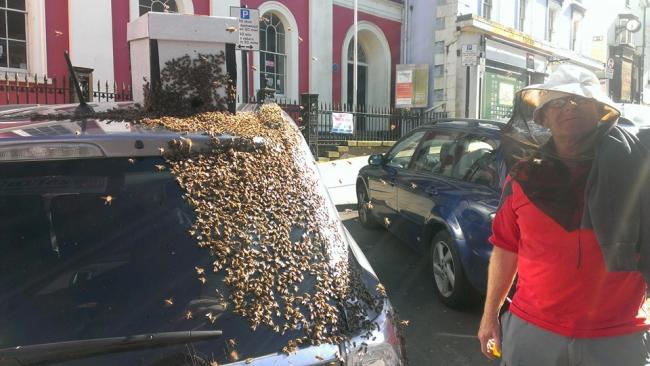
A grandmother in Wales got a shock last weekend, when she returned from a shopping trip to discover her car covered in thousands of bees, with several people attempting to remove the animals. Carol Howarth, 65, was even more amazed when the bees then chased her all the way home and staged a second mass swarming on her Mitsubishi Outlander.
Some 28 hours later, she was still being pursued and buzzed by the bees. Experts believe the queen bee had become trapped inside the car, and the rest of the insects were trying to reach her.
The bizarre incident began when Carol parked her car on Castle Square in Haverfordwest, Wales. While she was away, somewhere between 10,000 and 20,000 bees accumulated on the boot and side of the Outlander. Tom Moses, a Discovery Ranger for the Pembrokeshire Coast National Park, happened to be driving past, and spotted the swarming bees.
‘As a Discovery Ranger I’m aware of the importance of bees and their plight against pesticides and habitat loss, so I needed to help,’ Tom told the South Wales Argus afterwards. ‘I was a little worried, as the car was parked near some pubs, that someone would come and do something silly, so I wanted to make sure the bees were looked after.
‘I rang Roger Burns, after finding his number on the Pembrokeshire Beekeepers’ Association website, and luckily he came with a box and a bee keeping hat, and he started to get the bees in the box. Unfortunately, Roger had an appointment so had to go, but left his beekeeping equipment with Andrew Beyba, a passer-by and former beekeeper who stopped to offer a hand.
‘The bees started going into the box, and we were hoping the queen was in there, but then a sudden gust of wind blew the box off the car, and the lid came off and all the bees came swarming out again… It’s safe to say I got stung quite a few times.’
The dedicated Discovery Ranger then tracked down another number on the website, and another beekeeper was dispatched, fully equipped with a protective suit and bee smoker. ‘I was there for about three hours,’ said Tom. ‘I just wanted to make sure the bees were safe, because I know the importance of them: Maybe the town can now be renamed Hiverfordwest?’ Boom!

However, for Carol, the encounter wasn’t quite over. After driving several miles home, she discovered that more bees had followed her, and they began to swarm again. The tenacious insects were still tailing her 28 hours later, and she was forced to call out the bee keepers once more, to save her from the swarm.
‘One theory was that the queen was trapped in my car and the swarm were following her,’ said Carol. ‘Apparently bees can swarm at this time of the year and it is a very strong instinct for them to follow the queen.’
In this instance the queen was never located, but Carol is correct, this is bee swarming season. As weather conditions warm up during spring, bee colonies become bigger and sometimes reach a critical mass where they need to divide into two. In these circumstances, the existing queen will leave the nest and a new queen will be crowned in the hive.
As the original queen takes to the air, a large contingent of loyal worker bees will accompany her, along with some scout bees who will search for a new nest. Strongly attracted to the queen bee by her powerful pheromone, a swirling mass of thousands of worker bees will surround the queen at all times, and if she alights on something—be it a tree branch or a Mitsubishi Outlander—they will swarm around her.
If you encounter a swarm of bees in an inconvenient spot, do as Ranger Tom did and call in the experts—don’t attempt to move, capture or destroy them yourself, as this can be very dangerous (and Tom is right, bees are important and deserve to be treated with respect).
